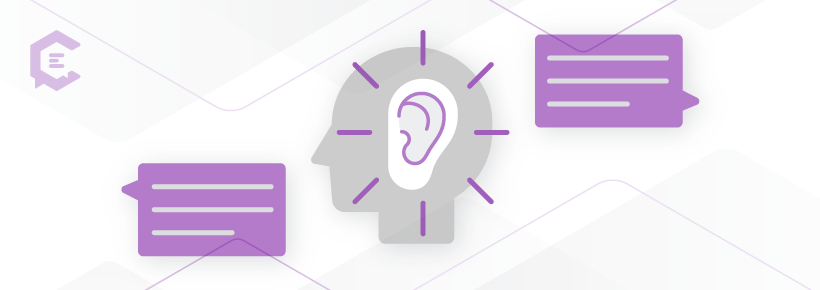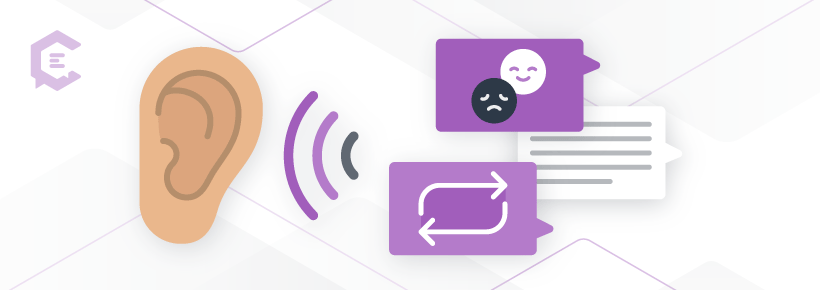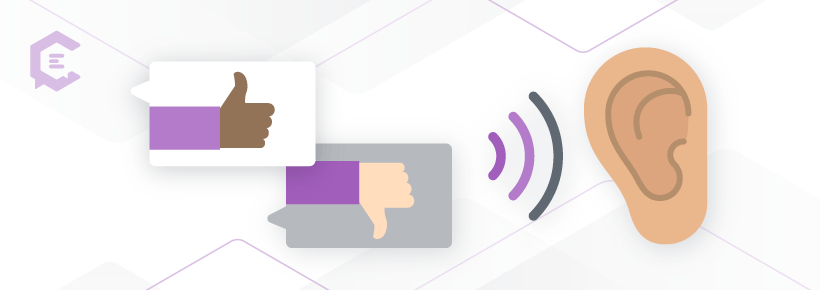Understanding the difference between just hearing words and actively listening can help you create content that better meets the needs of your brand and your audience.
From 24-hour news cycles to social and traditional media, we are bombarded by noise nearly every minute of every day, from every direction and every type of device.
It’s no wonder that with so much audible — and visual — noise coming at us, our ability to listen and truly engage has been compromised, so much so that the practice of active listening has moved beyond the confines of therapy and conflict resolution into our daily lexicon.
And given that so many of us are engaging with colleagues, friends, and even family via digital devices and platforms that are known to invite distraction, developing active listening skills is perhaps more important now than ever before.
As content creators, we know the importance of listening to our audience, to stakeholders, and to our team members too.
But do we listen actively, or do we just hear to react to the perfect sound bite, the perfect quote, or to seize an opportunity to interject our own thoughts?
Understanding the difference between just hearing words and actively listening can help you create content that better meets the needs of your brand and your audience.
What is active listening?
In our current, virtual-first society, it may seem that the practice of active listening is a new concept or popular trend.
In fact, active listening was first defined as a communication technique by authors Carl R. Rogers and Richard E. Farson in 1957.
In a booklet first published by the Industrial Relations Center at The University of Chicago, the authors suggested that “[supervisors and executives] must have, among other abilities, the ability to listen intelligently and carefully to those with whom [they] work.”
“The kind of listening we have in mind is called ‘active listening.’ It is called ‘active’ because the listener has a very definite responsibility. [They do] not passively absorb the words which are spoken to [them]. [They] actively try to grasp the facts and the feeling in what [they] hear, and [they] try, by [their] listening, to help the speaker work out [their] own problems.”
The University of The People defines active listening this way: “Active listening is a soft skill that directs the focus from what’s in your head to the words coming from the outside. By being able to focus on what another person is saying, you can understand needs and information more accurately.”
Active listening skills and emotional intelligence
It’s important to understand the concept and importance of soft skills before engaging in active listening.
Bruce Anderson, LinkedIn’s lead talent blog writer, says, “Soft skills are more about behavior and thinking, personal traits and cognitive skills.”
Anderson lists the top five soft skills as:
- Creativity
- Persuasion
- Collaboration
- Adaptability
- Emotional Intelligence
The last one on the list — emotional intelligence — is of paramount importance to the practice of active listening.
Citing the work of emotional intelligence expert Daniel Goleman, Anderson says that emotional intelligence is, “…a mix of self-awareness, self-regulation, social skill, empathy, and motivation.”
So what does all of this have to do with active listening?
For that answer, we return to Rogers and Farson: “To be effective, active listening must be firmly grounded in the basic attitudes of the user. We cannot employ it as a technique if our fundamental attitudes are in conflict with its basic concepts.”
Or more simply put: “To listen to oneself is a prerequisite to listening to others.”
Active listening techniques
Now that you have a good understanding of what active listening is, let’s unpack the requirements you’ll need to meet in order to put theory into practice.
According to Rogers and Farson, active listening requires you to:
- Listen for total meaning
- Respond to feelings
- Note all cues
- Test for understanding
Similarly, The University of the People lists the following requirements for active listening:
- Not interrupting
- Summarization
- Repeating what you hear back
- Picking up on body language
Taken together, putting the theory of active listening into practice involves:
- Listening for the content of the message, as well as the feeling(s) underlying the content
- Acknowledging or responding to the feeling(s) expressed
- Paying close attention to verbal cues, such as inflection and patterns of speech, as well as facial expressions, posture, and other non-verbal cues
- Reflecting or repeating the message back to the speaker in your own words, to the satisfaction of the speaker
From Rogers and Farson: “[Active listening] requires that we get inside the speaker, that we grasp, from [their] point of view, just what it is [they’re] communicating to us. More than that, we must convey to the speaker that we are seeing things from [their] point of view.”
Using active listening to craft better content
Content creators are curious by default. In fact, when asked what I believe to be the most important skills for a content creator to have, I regularly include curiosity high on the list. And the best way I know to satisfy that curiosity is by asking questions.
But the type of questions asked can make or break your ability to get at the gist of what the speaker is actually saying. To make that connection, you need to master the power of the open-ended question. And, it’s also helpful to know when a closed-ended question will do instead.
In The Ultimate Guide to Open-Ended Questions vs. Closed-Ended Questions, ClearVoicer Lena Katz lays out compelling reasons to employ open-ended questions, and calls particular attention to how these types of questions can help foster “…stronger connections, better insights, and more business,” as well as how marketers can use open-ended questions to “maximize authentic engagement with new business leads and current clients.”
Open-ended questions are also a great tool for eliciting content requirements from stakeholders and product owners, as well as to obtain insights from consumers who engage with a brand’s digital platforms and other communication channels.
Katz also stresses the importance of knowing when to ask open-ended questions vs. closed-ended: “…there’s method and skill required to ask open-ended questions… and part of it is realizing and leveraging the other, equally important benefits of asking closed-ended questions.”
Paired with active listening, knowing the right types of questions to ask — and when and how to ask them — will help you glean information that will help you to craft content that is memorable and fosters authentic connection and engagement between your brand or subject and your intended audience.
5 Do’s and 5 Don’ts of active listening for better content
Searching the internet for “active listening do’s and don’ts” yields myriad lists of best practices to employ, as well as pitfalls to avoid.
One list in particular that feels appropriate for content creators comes from author Donna Long of Learning Journey Inc.:
Do…
- Face the speaker (or in these COVID times, turn on your webcam!)
- Keep comfortable eye contact
- Give the speaker your full attention
- Be open to the speaker’s message
- Display clues that you are listening without agreeing or disagreeing with the message (i.e., “I see”)
Don’t…
- Interrupt
- Judge
- Think about what you are going to say next
- Offer advice or solutions
- Be defensive
3 Active listening examples
Rogers and Farson warn that our own emotions can sometimes act as a barrier to active listening. Things like defensiveness, resenting opposing views, or personality clashes can sometimes get in the way of getting to the meat of a message.
And if all of that sounds like dynamics you’d find in personal communications, I’d urge you to consider the following scenarios, all from my personal experience, and all based on a list of what Rogers and Farson call danger signals:
1. Defensiveness
This can occur when the person you are interviewing takes issue with how you’ve phrased a question, or with the question itself. “Why are you asking me that?” can put you on the defense, and understandably so.
Remember that the interview isn’t about your intelligence or your interviewing skills. Instead of becoming defensive, gently guide the interviewee back to your shared goal(s): to articulate a value proposition or mission statement, to describe the benefits of a product or service, or to give the subject a platform to express themselves or their views in a non-judgmental way.
2. Resentment of opposition
Sometimes the person you are interviewing may express a view that is in opposition to your own values and beliefs, such as when you’re interviewing a stakeholder who is averse to your synthesis of the audience’s understanding of a concept, or when you’re interviewing a subject for a profile piece who has different political views or business ethics.
Remembering that you’re listening to understand and not to impose your own ideas can help you navigate situations like this with grace while maintaining your cool. Note that this does not mean that you shouldn’t ask questions for clarification, or bring up a view or position that is widely known to be the opposite of what the subject has expressed. By simply asking if they’ve considered another view, you can invite them to share their feelings in a non-confrontational way.
3. Clash of personalities
While this may sound similar to the previous example of opposition resentment, a clashing of personalities is a bit more, um personal, and brings us back to the concept of emotional intelligence. Examples of potential clashes can come from interviewees of all stripes, such as a leader of a large organization who isn’t accustomed to being questioned — even politely and professionally; a civic or municipal figure who may find themselves being questioned about a controversy; or even a product or marketing manager who bristles at your interpretation of the product or service you’re crafting content about, and who has their own idea of how to say — or write — it better.
In this situation, you’ll want to focus on establishing trust by signaling through your words and actions that it’s OK for the interviewee to share openly, and by establishing from the beginning that expressing themselves fully will ultimately help you get a full and accurate picture of whatever it is they wish to express.
“By becoming a better listener, you can improve your productivity, as well as your ability to influence, persuade and negotiate.” – MindTools






